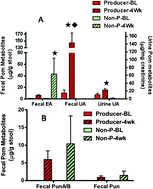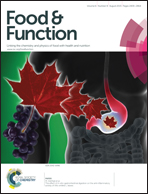Pomegranate extract induces ellagitannin metabolite formation and changes stool microbiota in healthy volunteers†
Abstract
The health benefits of pomegranate (POM) consumption are attributed to ellagitannins and their metabolites, formed and absorbed in the intestine by the microbiota. In this study twenty healthy participants consumed 1000 mg of POM extract daily for four weeks. Based on urinary and fecal content of the POM metabolite urolithin A (UA), we observed three distinct groups: (1) individuals with no baseline UA presence but induction of UA formation by POM extract consumption (n = 9); (2) baseline UA formation which was enhanced by POM extract consumption (N = 5) and (3) no baseline UA production, which was not inducible (N = 6). Compared to baseline the phylum Actinobacteria was increased and Firmicutes decreased significantly in individuals forming UA (producers). Verrucomicrobia (Akkermansia muciniphila) was 33 and 47-fold higher in stool samples of UA producers compared to non-producers at baseline and after 4 weeks, respectively. In UA producers, the genera Butyrivibrio, Enterobacter, Escherichia, Lactobacillus, Prevotella, Serratia and Veillonella were increased and Collinsella decreased significantly at week 4 compared to baseline. The consumption of pomegranate resulted in the formation of its metabolites in some but not all participants. POM extract consumption may induce health benefits secondary to changes in the microbiota.


 Please wait while we load your content...
Please wait while we load your content...